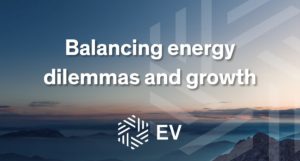Sustainability News
Balancing energy dilemmas and growth
By Einar Gamman, Senior Partner

In a series of blogs, our senior partner, Einar Gamman explores the industry’s hot topics – the burning questions we need to address to guarantee the oil and gas sector doesn’t just survive but thrives.
Einar discusses the importance of balancing the demand for energy with the need for sustainability; the vital role of digital transformation, as well as how we can continue attracting young talent into the industry. This is the first in a series of three:
Whether we like it or not, where we get energy from and how we get it is facing a fundamental challenge.
Some call it the dual challenge, where there’s still increasing demand for energy, but where it needs to be both cheaper and cleaner. Others call it the energy trilemma: the world needs more energy, but it needs to be affordable in order to enable GDP growth; it needs to be promoting a sustainable and environmentally friendly future; and it needs to be secure and reliable.
Balancing energy dilemmas is a mega trend – and it’s gaining a very strong momentum.
These changes are being supported by research and an increasing global awareness and are broadly supported by a growing number of policy makers, nations and organizations. It is a self-imposed movement that is getting stronger and stronger every day, driven in no small part by the Paris Agreement – the global convention, laid out in 2015, that brought nations across the globe together for the first time, to jointly agree on combating climate change. Today, at the turn of 2018, we see most of the world leaders reiterating the importance of this change, perhaps even advocating a strengthening of the efforts.
A key contribution to combating climate change is the tremendous focus we are seeing on energy efficiency. The best example is the global focus on, and growth in, electrification. But, there is also a constant push for efficiency gains in all aspects of our energy consumption. Even with a continued growth in the global population for another century to come, recent predictions suggest that the world’s energy demand/consumption will in fact peak in the mid-2030s and will only then gradually start to decrease. Why? Because we are getting much better at energy efficiency.
But, make no mistake, oil and gas will remain an important part of this energy mix for the foreseeable future. Most research and projections predict that oil and gas will represent more than 50% of the energy mix at least until 2050. Key resources like the US unconventional basins will continue to play a significant role in global oil and gas supply over the next two decades, if not longer – in fact, they will become tomorrow’s conventional resources. But, we will start to see a balancing act over which resources are brought to production and at what financial and environmental cost.
The resources we access will be subject to stricter legislation, to ensure that reservoirs are not just creamed off and then abandoned. There will be an even tougher drive to achieve the highest possible recovery rates from existing reservoirs, which will require a relentless pursuit of technological improvements and improved business models, all targeted at getting more for less. These issues are all part of our dual challenge. We cannot afford to stand still. We need to be looking for tools, technologies and services that lower the cost of exploring for and exploiting oil and gas reserves, as well as reducing risk and improving performance; getting more out of each and every reservoir. And, we need to do all of this while focusing on, and always having in mind that, going forward we will not be allowed to continue to emit CO2 and Methane as part of our operations, as is done today. The national, multinational and major oil companies, that dominate our industry, are both expected to act and are now seen to be actively taking steps to act upon their social responsibility and leading the way here.
Want more from Einar? Check out our ‘Insights’ playlist on YouTube to watch his series of videos.